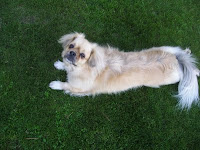When discs are suddenly herniated most dogs experience intense pain. A study published Aug 31, 2011, by doctors from the Orthopaedic Department, East Chamber, Beijing Military General Hospital, Beijing 100026, China showed that effects of acupuncture treatment were comparable to the effects of surgery.
Which Dog Breeds Are Predisposed to Develop Disc Disease?
There is a high incidence of ruptured discs in dogs with chondrodystrophy or those with long backs and short legs:
• Beagle,
• Bichon Frise,
• Chihuahua,
• Cocker Spaniel,
• Corgi,
• Dachshunds,
• Lhasa Apso,
• Miniature Poodle,
• Pembroke Welsh Corgi,
• Pekingese,
• Pomeranian,
• Pug,
• Tibetan Spaniel.
Disc Disease also occurs in large breed dogs, but is more often a slow compression of the disc than a rapid injury. Large-breed dogs prone to develop disc disease are the:
• Dalmatian,
• Doberman Pinscher,
• German Shepherd,
• Great Dane,
• Labrador Retriever,
• Rottweiler,
• Siberian Husky.
If your pet is one of these dog breeds, take steps to prevent disc disease. If disc disease occurs and you cannot afford surgery, have your holistic veterinarian treat your pet with acupuncture.
reade more...
Which Dog Breeds Are Predisposed to Develop Disc Disease?
There is a high incidence of ruptured discs in dogs with chondrodystrophy or those with long backs and short legs:
• Beagle,
• Bichon Frise,
• Chihuahua,
• Cocker Spaniel,
• Corgi,
• Dachshunds,
• Lhasa Apso,
• Miniature Poodle,
• Pembroke Welsh Corgi,
• Pekingese,
• Pomeranian,
• Pug,
• Tibetan Spaniel.
Disc Disease also occurs in large breed dogs, but is more often a slow compression of the disc than a rapid injury. Large-breed dogs prone to develop disc disease are the:
• Dalmatian,
• Doberman Pinscher,
• German Shepherd,
• Great Dane,
• Labrador Retriever,
• Rottweiler,
• Siberian Husky.
If your pet is one of these dog breeds, take steps to prevent disc disease. If disc disease occurs and you cannot afford surgery, have your holistic veterinarian treat your pet with acupuncture.







